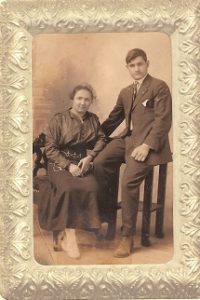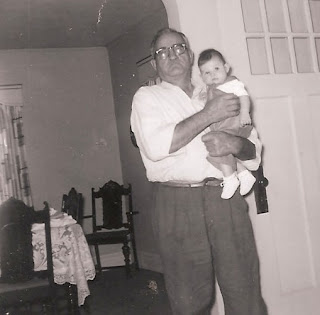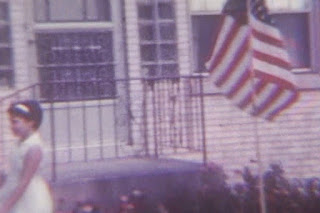A FABULOUS FIND of 3 July 2015.
Originally published on genealogyatheart.blogspot.com on 2 Jul 2015.
Growing up, I would often ask my grandma to tell me stories about the Old Country.* Immigrating to the US with her mother and brother a week before her 13th birthday, my Non preferred to tell the tales she had heard from her elders and not those that she recalled herself. I’ve previously mentioned my own faulty memories so I wondered, as an adult, about the family lore and how much truth was contained in those stories.
When I asked Non where she came from she would always smile and say, “I was born in a little village outside of Zagreb in what was then Austria-Hungary but we came there from other places.” Non would go on to say that our family moved about long ago from a land far away, an island south, and before that, a land far to the east. She did not know the name or locations of these places nor the time period that the moves were made. I would push for more; why did the family move to begin with? Non said the first move was because of violence. Due to some long ago forgotten period of unrest the family decided to move west. They were farmers and they were looking for a safe place to raise their crops. After traveling for a long time the family settled on an island somewhere but Non did not know where. Why did they move from the island? Non claimed that due to overpopulation and soil over use, farming was not as prosperous as it once was so the family moved on, searching for another location. Ultimately, they settled in the Zagreb area with other families that chose to leave when they did. The destination was almost heaven to them, clear springs, fertile soil, mountains for protection, and there the family remained for years.
I wanted to determine if the stories were true and if so, where the location of the island and the land to the east was might have been. Several years ago I took an Ancestry DNA test with the results showing my maternal line belonged to Haplogroup H. “The Colonists are believed to have arrived in Europe from western Asia about the same time as a culture known as Gravettian. For that reason, it’s probable that the Colonists adopted or even originated the Gravettian technology. “1
So Non was correct, the family had moved from the east. A second cousin shared his maternal results with me that he had done by National Geographic. The results confirmed that his mother and my Non, who were sisters, both tested as Haplogroup H and the movement is from east to west. See his “Eve” line below:
But what about the island story? National Geographic does mention “Haplogroup H is a great example of the effect that population dynamics such as bottleneck events, founder effects, genetic drift, and rapid population growth, have on the genetic diversity of resulting populations.”2 Although I can’t prove it, there is oddly a Kos Island in the Dodecanese chain of the Aegean Sea that perhaps was why my family became known as Kos’. Kos as a name (Greek: Κῶς, genitive Κῶ)3 has been first documented in Plato’s Illiad. In Croatian, it is known as a blackbird or crow and is the 45th most common name in Croatia today.4 The travel route is in line with migration patterns and strangely, these locations are a “as the crow flies” since Kos Island is located in a straight line with Zagreb.
Moreover, the story of farming is further confirmed as historically, the Kos Island was known for its crops of grapes, almonds, figs, olives, wheat, corn and lettuce.5 My family loved grapes (and vino!) of which I still grow today and they continued to grow in their new home in Croatia.
With the premise that there is a basis in Non’s stories, I began to research migration pattern timelines to try to determine where my ancestors resided in the past. My Aunt Anne Marie had sent my mom an undated clipping from the Zajednicar, a Croatian-American newspaper published by the Croatian Fraternal Union. Entitled, The History of Croatia, Lodge 793 member Gordon J. Z. Bobesich wrote that “There is a theory that the name “Hrvati, which is what the Croats call themselves is Persian in origin.” Persia is known as Iran today and does show on the maps above as a possible place of origin. Since the article was undated and I was unable to locate a citation online I decided to further search for more recent research of a Persian-Croatian connection.
I also decided to check out my maternal grandfather’s origin story. Also surnamed Kos and a distant cousin of my grandmother, Non said Gramps’ people were of gypsy heritage. Gramps was dark complected with brown hair and eyes. Non was fair with blue eyes and lighter brown hair.

Gramps’ ancestors, “The Gypsies, or Romanies, are an ethnic group that arrived in Europe around the 14th century. Scholars argue about when and how they left India, but it is generally accepted that they did emigrate from northern India some time between the 6th and 11th centuries, then crossed the Middle East and came into Europe.” 6
SPOLIER ALERT – I was unprepared for what I discovered.
On Non’s side, I first found the following, “Historical studies indicate that the Croats started migrating from the Iranian homeland to Croatia, Serbia and Bosnia about 3,000 years ago. However, a much larger migration took place about 1,700 years ago. Probably the reason behind this migration was the suppression of the followers of Manichean faith during the Sassanid era.”7 This not only supported the DNA evidence but also that the original reason to leave which was due to conflict. Now I had a time period of about when the original migration occurred. I then discovered that since the 4th Century BCE, a “presence of Iranian-speaking Iazyges”8 resided along side the Greeks throughout the Aegean region. This further confirmed the Kos Island connection.
Further research uncovered that although the Persia to the Dodecanese to the mainland of Croatia most likely was my maternal grandmother’s families’ route, others have a different take on who are the present day Slavs.
I learned that there are several theories as to how today’s Slavs originated. Some believe that the Goths, as noble barbarians, were the original settlers to the region. Others postulate that 5 brothers and 2 sisters of an upper-caste of the Avar-Bulgarians moved into the area. The Slavic view believes groups belonging to the Illyrians, an Indo-European people who always resided in the Balkans, moved from southern Poland and northern Ukraine to settle. At this point my research uncovered extremely racist posts which showed that the area’s tensions have not ceased since the last war. How very sad, after all these years, that people cannot just get along and accept that we are all human. Did anyone stop to think that all 4 emigration theories might be correct? My grandmother’s most likely was the Persian theory and my grandfather’s ancestor’s migration as gypsies is not even considered as a theory, I suppose because after their near extermination during World War II, gypsy lineage is not what many Slavs wish to think about today.
I was so disturbed after reading the many racist posts that demonstrated a Superiority Complex disorder that I had difficulty sleeping.
I strongly believe the roots of racism is the need to feel more superior (upper-caste, noble) and to be first (always resided) which somehow relates to best. I am deeply disappointed that these needs still exist. I was sickened by the many posts of Croats, Serbs, Bosnians and Iranians who seem to think that they are genetically superior. With the recent events in the US and throughout the world, that region is clearly not alone in its racist beliefs. I simple can’t understand this mindset!
I am proud to be a mutt – yep, I am a mix of so many diverse ethnic groups who found love in someone different from themselves but realized that was what was important – not domination, hatred and narrow mindedness.
We all have prejudices, myself included, but we must work towards understanding and acceptance.
Dionne Warwick sang it best: What the world needs now is love sweet love, / It’s the only thing that there’s just too little of. / What the world needs now is love sweet love, / No not just for some but for everyone.

1Ancestry.com Maternal Lineage Test Result
2National Geographic and IBM Maternal Lineage Test Results, p. 17.
3Liddell et al., A Greek–English Lexicon, s.v.
4“Croatian Names.” Croatian Genealogy & Family History. N.p., n.d. Web. 27 June 2015.
5 “Kos Island.” Wikipedia. Wikimedia Foundation, n.d. Web. 27 June 2015
6 Kenrick, Donald (2007). Historical Dictionary of the Gypsies (Romanies) (2nd ed.). Scarecrow Press. p. xxxvii.
7 “Culture of Iran: Croatians and Cravats Are of Iranian Origin.” Culture of Iran: Croatians and Cravats Are of Iranian Origin. N.p., n.d. Web. 27 June 2015.
8Heršak, Emil; Nikšić, Boris (2007), “Hrvatska etnogeneza: pregled komponentnih etapa i interpretacija (s naglaskom na euroazijske/nomadske sadržaje)” [Croatian Ethnogenesis: A Review of Component Stages and Interpretations (with Emphasis on Eurasian/Nomadic Elements)], Migration and Ethnic Themes (in Croatian) 23 (3)
*Mary Violet Kos Koss, my maternal grandmother, would have been 115 years old on July 18th. I’ll be spending the next few posts on my Croatian ancestors’ stories trying to confirm their accuracy and to learn more about the events that were remembered.










